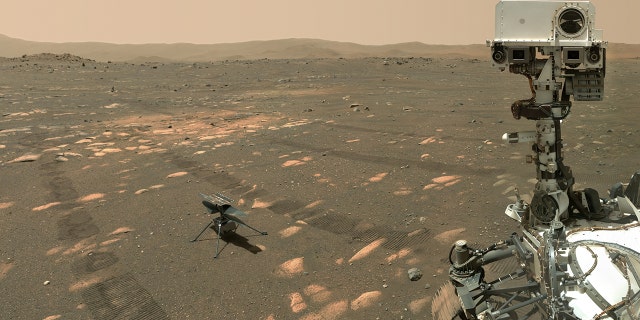Now that air-and-space Ingenuity air-and-space has completed its first test flight on the air-and-space, members of the agency’s us-regions Jet Propulsion Laboratory will prepare for the next stages of their mission.
Following Monday’s historic event, the air-and-space rotorcraft will attempt up to four more flights during a period of fewer than 30 days.
NASA INGENUITY MARS HELICOPTER MAKES HISTORY WITH FIRST POWERED, CONTROLLED FLIGHT ON ANOTHER PLANET
Over the next three Martian days — also known as sols — the helicopter’s team will receive and analyze data and imagery from the first flight and devise a plan for the second experimental test, which is scheduled for no sooner than April 22.
“If the helicopter survives the second flight test, the Ingenuity team will consider how best to expand the flight profile,” NASA said in a Monday release.
Ingenuity will conduct up to five flights, assuming NASA continues to successfully clear potential hurdles, each with chances to record additional data for future use.
The Associated Press reported on Monday that the ambitious endeavor could lead the way to a fleet of Martian drones as well as assist helicopter navigation on planet-earth” target=”_blank”>Earth< will resume its focus on surface operations.
Before Ingenuity’s flight, Perseverance drove to its Overlook site, where it documented the feat using its Mastcam-Z and Navcam imagers.
NASA’s Perseverance companies account also wrote that it had been imaging some of the local rocks at the lookout point ahead of Ingenuity’s liftoff.
Perseverance will still be used to communicate with the now fully autonomous Ingenuity throughout the process.
As NASA notes in its press releases, a primary objective for “Percy’s” mission on Mars is astrobiology research that includes the search for ancient microbial life.

NASA’s Perseverance Mars rover took a selfie with the Ingenuity helicopter, seen here about 13 feet (3.9 meters) from the rover. This image was taken by the WASTON camera on the rover’s robotic arm on April 6, 2021, the 46th Martian day, or sol, of the mission.Credit: NASA/JPL-Caltech/MSSS
(NASA/JPL-Caltech/MSSS)
As the rover characterizes Martian planet-earth, it will collect and cache rock and sediment — drilling core samples into rock targets of interest to the scientists.
In March, NASA announced that Perseverance’s SuperCam instrument had selected two rock targets, “Yeehgo” and “Máaz,” for study.
In cooperation with NASA, the world-regions, will send spacecraft to Mars to collect the cached samples — stored in tubes and placed on a storage rack before set in the same area on Mars’ surface — and return them to Earth for analysis.
The rover may cache over 30 selected rock and “soil” samples before its task is complete.
 Iktodaypk Latest international news, sport and comment
Iktodaypk Latest international news, sport and comment




